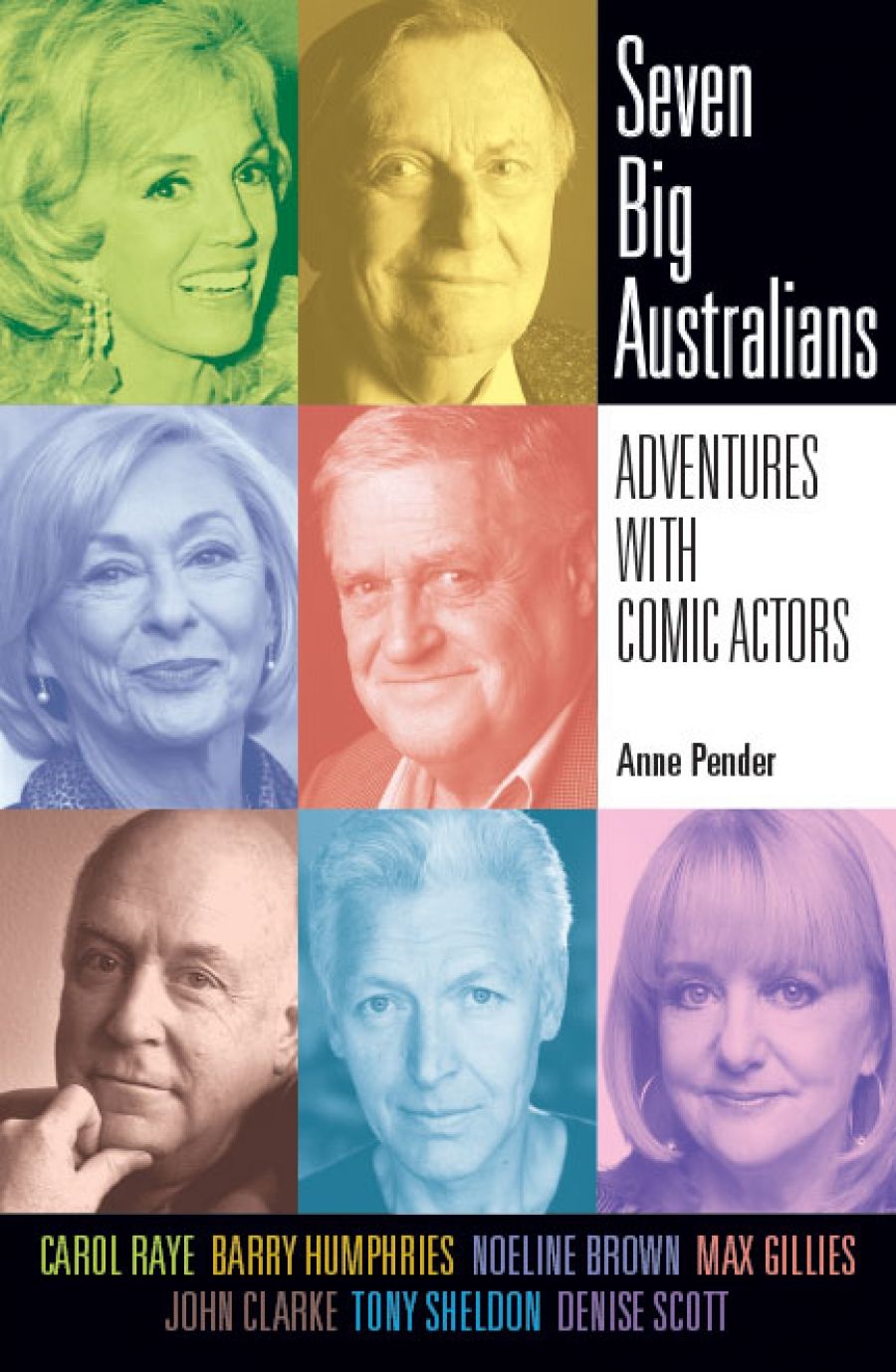
- Free Article: No
- Contents Category: Theatre
- Custom Article Title: Desley Deacon reviews <em>Seven Big Australians: Adventures with comic actors</em> by Anne Pender
- Custom Highlight Text:
Nowadays every second young person seems to want to be a stand-up comic, an occupation that perfectly represents the ‘gig’ economy in its precariousness and occasional nature. Anne Pender gives us mini-biographies of seven Australians who succeeded, often spectacularly, in the risky business of being a comic long ...
- Book 1 Title: Seven Big Australians
- Book 1 Subtitle: Adventures with comic actors
- Book 1 Biblio: Monash University Publishing, $29.95 pb, 292 pp, 9781925835212
Although these are individual portraits, one of the pleasures of the book is the collective picture that emerges of a glorious time in television and theatre, when programs like The Mavis Bramston Show introduced adult entertainment with a capital A at a time (1964) when, to quote its creator, Carol Raye, ‘No one even said bum on TV.’ These are people whose careers overlapped in Melbourne, Sydney, and London in the Pocket Playhouse, the Phillip Street Theatre, the Pram Factory, La Mama Theatre, and in the Barry McKenzie movies Number 96, The Naked Vicar Show, Don’s Party, and Squirts. The names of Barry Creyton, Graeme Blundell, Phillip Adams, Clive James, John Bell, Bruce Beresford, Helen Garner, David Williamson, Patrick Cook, Don Watson, Jeffrey Smart, and Robert Hughes dot the pages in all sorts of permutations and combinations. (Be warned: there is no index to help you find these personalities.)
 Actor and comedian Maggie Dence in a publicity still for The Mavis Bramston Show in 1965
Actor and comedian Maggie Dence in a publicity still for The Mavis Bramston Show in 1965
These stories also provide a revealing social history of the period. An important theme is the introduction of trauma into the life of families as a result of the war. Parents’ marriages were troubled and often ended in bitter divorces where the father disappeared from their children’s lives – by banishment or even suicide. The horrors of the divorce court in 1960s New Zealand were particularly appalling in Clarke’s account. With one thing and another, as Clarke put it, not much parenting was done. For these boys, life-changing mentors save them from directionless drifting – a sympathetic teacher or an enthusiastic amateur director who recognises their potential. None of these seven went to NIDA, though Max Gillies gives a particularly chilling account of his (unsuccessful) audition with Robert Quentin. As usual with talented outsiders, once launched on their trajectory peers were their most important influence and support. Patrick Cook, Don Watson, and John Clarke were central for Gillies. As for John Clarke, it was Phillip Adams, Paul Cox, and Max Gillies who encouraged him to play himself.
The women among these seven had different trajectories. Carol Raye, born in 1923, began her career just before the war. She had a happy childhood and seemed to sail confidently through marriage, childrearing, and looking after ageing parents, constantly refreshing a career through periods in Kenya, Australia, England, and back again in Australia. Noeline Brown, born in 1938, also had a happy childhood and fell accidentally into amateur theatre and eventually television, where The Mavis Bramston Show gave her an opportunity to shine. Denise Scott, born in 1955, had a darker childhood, not because it was an unhappy family but because of her own anxiety and self-doubt. Unlike the men, she does not seem to have found a mentor, and her story is one of perseverance in the face of imminent disaster. She did her first stand-up at the age of thirty-four in 1989, fighting against extreme stage fright, and her accounts of aggressive hecklers and unresponsive audiences are agonising. With Judith Lucy, she pioneered a new sort of feminist comedy where nothing – childbirth, menstruation, bad sex – was taboo, attracting in the process a new audience of older women.
These stories provide some delightful, revealing, and surprising bits of information. Raye’s style in the 1940s is described evocatively as ‘frisky demureness’. Brown’s boyfriend in the early 1960s was Robert Hughes, and her character, ‘Possum,’ in My Name’s McGooley, What’s Yours? was the inspiration for Humphries’ famous greeting ‘Hello Possums’. Humphries’ 1977 attempt to storm the United States was an abysmal failure. Bob Hawke showed his ambivalence about Gillies’ portrayal of him by giving him a ‘friendly but not painless’ bop on the nose when they appeared together at the North Melbourne Football Club.
Seven Big Australians has much to amuse and much to teach. But be warned: it induces intense nostalgia and longing in those over sixty. It made me want to write to the ABC and the various commercial channels: please set up a channel that replays Mavis Bramston and its like, and screens landmark films such as Don’s Party and Travelling North. And how about a series of interviews with key people of this era before, like John Clarke? They are gone from us forever.


Comments powered by CComment